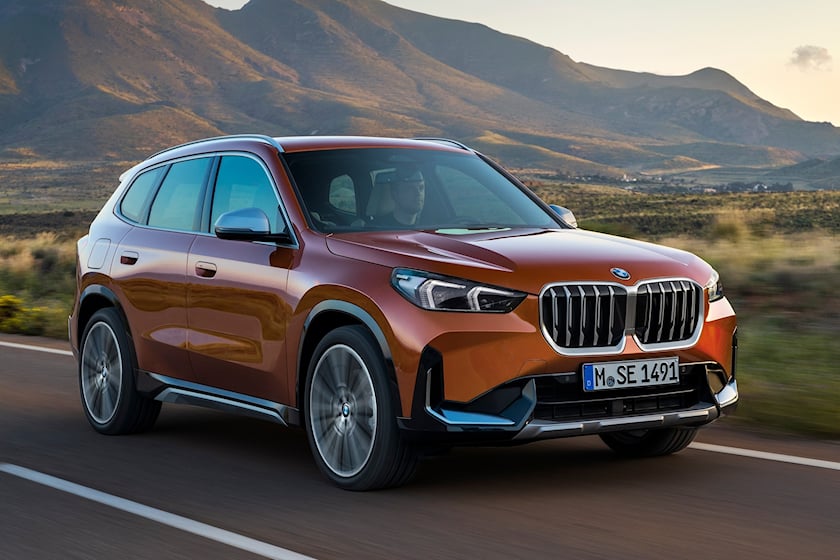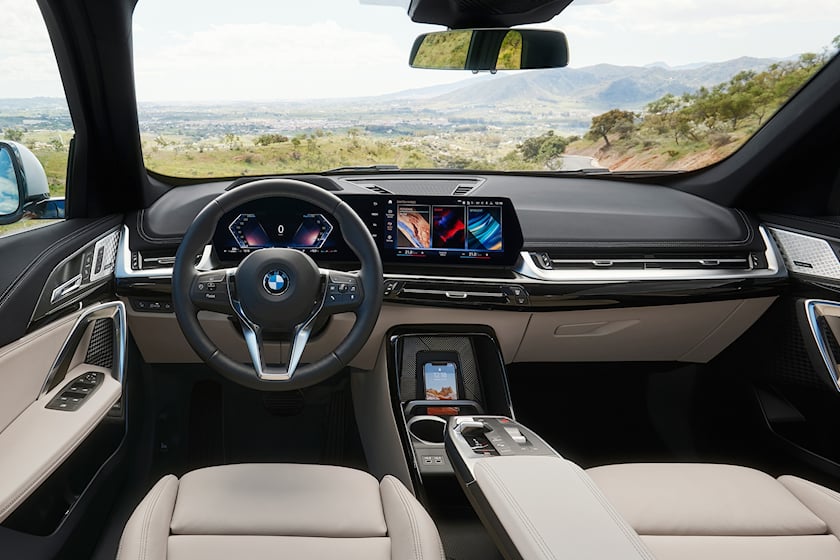The third-generation BMW X1 has officially been unveiled. As the world transitions to high-riding crossovers, or what BMW deems 'Sports Activity Vehicles', we're seeing a gradual shift away from the sports sedan and the luxury subcompact X1 is rapidly becoming the go-to for buyers wanting an entry-level BMW model. Based on the same FAAR platform as the previous generation X1, Mini Countryman, Mini Clubman, and even the 2 Series Gran Coupe, the basic recipe is the same with a front-wheel-drive-based platform, BMW's signature refined engines, and soft-touch materials wherever you lay fingers. But with a new Mercedes-Benz GLA-Class on the scene and the Lexus UX and Audi Q3 in buyers' crosshairs, BMW has focused its developmental might on new technologies inside and out, and, for the European market at least, an electric twin called the iX1.
See trim levels and configurations:
| Trim | Engine | Transmission | Drivetrain | Price (MSRP) |
|---|---|---|---|---|
| xDrive28i |
2.0L Turbo Inline-4 Gas
|
7-Speed dual clutch Automatic
|
All-Wheel Drive
|
$38,597 |
Revealed at the beginning of June 2022, the BMW X1's release date for the USA is the fourth quarter of this year as a 2023 model year.
With a new generation crossover, BMW has seen fit to increase the base MSRP of the 2023 X1 by $3,200. The 2023 BMW X1 has a base price of $38,600 excluding a $995 destination charge. It is available solely in the X1 xDrive28i trim, which is $1,200 more expensive than the outgoing AWD model. A comparable Mercedes GLA 250 4Matic costs $38,400, placing BMW's pricing right in the same ballpark as its rivals. Other competitors include the Volvo XC40 and Audi Q3.
Get used to seeing the word 'monolithic' in reference to BMW's new design language for its SUVs. While not quite as sheer in its surfacing as the X7, there are definite allusions to the full-size halo with slab-like surfaces, flush door handles, prominent squared-off wheel arches, and a bold front face with large, but not excessive kidney grilles. Even the daylight opening for the windows is decidedly square, lacking the classic Hofmeister kink. The exception to the big, bold design is the LED headlights, which are drawn back over the front corners of the car.
The LED taillights are more traditional, with L-shaped housings that blend into a full-width bar beneath the rear windscreen and badge, while the roof-mounted spoiler takes a distinct double-bubble shape first displayed on the Concept XM. The angular wheel arches are filled by default by 18-inch V-spoke alloy wheels on all-season tires, while the roof rails, grille surrounds, window surrounds, and other details are finished in Satin Aluminum.
Buyers can opt for a style of their own with a more rugged Design xLine appearance package. This adds more rugged exterior elements, finishes all the Satin Aluminum highlights in Pearl Effect chrome, and adds 18-inch alloys with optional 19- and 20-inch items, the latter a first for the X1. Alternatively, the M Sport Package gets blacked-out Shadowline trim and aggressive front and rear fascia designs for the exterior of the BMW X1.
As for the new BMW X1's colors, 13 paint options have been made available. The returning hues include Alpine White, Jet Black, Black Sapphire, Mineral White, Phytonic Blue, Portimao Blue, Storm Bay, and San Remo Green, but the Bavarian brand has added some excitement with five exciting new options: Space Silver, Utah Orange (pictured), Cape York Green, Blue Bay Lagoon, and BMW Individual Frozen Pure Grey.
It might still be classified as a luxury subcompact and ride on the same platform, but the new BMW X1 SUV is larger than its predecessor. At 177.2 inches long, 72.6 inches wide, and 64.6 inches tall, it has swelled by 1.7-, 0.9- and 1.7 inches in each metric respectively. The 106-inch wheelbase is 0.9 inches longer than before, while the increased track widths will aid handling and stability. 8.1 inches of ground clearance is standard, but the available adaptive M suspension lowers this by a further six-tenths of an inch.
Despite growing in size, the new X1 is only 44 lbs heavier than before at a curb weight of 3,750 lbs.
While it inherits the same X1 xDrive 28i nomenclature as the 2022 model, the BMW X1's engine has been massaged a little for improved performance. The motor is still a 2.0-liter turbocharged four-cylinder, but it now uses a Miller combustion cycle, a combination of port and direct fuel injection, and revised combustion chamber geometry. The result is an increase of 13 horsepower and 37 lb-ft of torque for final specs of 241 hp and 295 lb-ft. There's a new transmission, too, with the old torque converter auto making way for a seven-speed dual-clutch automatic (DCT). Paired exclusively with all-wheel drive (last year's FWD option is gone), the X1 28i xDrive will make the 0-60 mph sprint in 6.2 seconds before reaching an electronically limited top speed of 130 mph on all-season tires and 149 mph with performance rubber.
BMW claims that the X1 is a "Sporty and capable all-rounder for adventure and the everyday." In order to meet this standard, the suspension has been redeveloped with new axle kinematics, aluminum hydromounts, and recalibrated steering that is quicker and provides more feedback. The rear suspension is now three-link in nature and partnered with a rear-axle subframe. Compact springs and dampers meanwhile are more capable but take up less space. The mechanical systems are aided by new wheel slip limitation systems in the stability control to adapt how it intervenes based on your driving and the road conditions at hand.
Adaptive M suspension rides 0.6 inches lower, boasts frequency-selective damping, and has revised sport steering with a more direct ratio on the steering rack.
The new X1 hasn't yet visited the EPA's test facilities to determine its American gas mileage and fuel economy numbers. With more power and a slew of revisions, however, it's not unreasonable to expect changes to the model we've become familiar with. The new DCT gearbox with widened ratios and involvement from the GPS system based on the topography of your drive will likely yield improvements, and BMW has developed new low-friction wheel bearings that are said to enhance the crossover's economy. As a guideline, the 2022 BMW X1 xDrive28i returned 23/31/26 mpg city/highway/combined. We expect an improvement over those figures, which would pair well with the new car's 14.3-gallon gas tank.
American buyers should be pleased to know that the larger dimensions of the BMW X1 yield beneficial improvements in terms of its passenger space. The 2023 BMW X1's interior seats five adults in two rows with more shoulder room than before, although exact interior measurements haven't been published. The seats on which occupants sit are newly designed and are said to improve long-distance comfort, whether in standard or Sport design. As standard, they are upholstered in SensaTec 2.0 leatherette, available in Oyster with contrast stitching, Red/Black, solid Black, or Mocha with contrast stitching. Illuminated interior trim is gloss black by default but can be upgraded with options including open-pore Eucalyptus and Aluminum Hexacube inlays.
Technologically, the new X1 has taken a massive leap forward, inheriting iDrive 8 from larger BMW models. Here, it's encompassed on a curved display occupying most of the dash. Comprising two screens - a 10.25-inch instrument cluster featuring BMW Live Cockpit Plus and a 10.7-inch central infotainment screen. For only the second time, a modern BMW does without the rotary iDrive controller (the first was the European 2 Series Active Tourer), relying on touch, steering wheel commands, and voice control.
Functionality is enhanced with new tech like augmented reality navigation, the full BMW Intelligent Personal Assistant suite, and the My BMW App. The latter allows you to take your personal settings with you from vehicle to vehicle via a BMW ID, remembering everything from mirror and seating position to display layouts and infotainment preferences. Naturally, the likes of Apple CarPlay and Android Auto are standard, and BMW's Digital Key Plus allows iPhone users to use their phone as a key. An available head-up display augments the curved display for extra information.
The BMW X1's cargo space is large and practical, although its capacity hasn't been confirmed. It's likely to be around the same as the previous model's 27.1 cubic feet. 40/20/40-split folding rear seats provide versatile loading options, and we expect the new model to surpass the old car's 58.7-cube maximum capacity. With the iDrive controller now gone, a new floating armrest design improves in-cabin storage space with a large storage area beneath it, twin cupholders, and a smartphone tray with a movable clasp to hold them against the wireless charging tray.
The most popular competitors of 2023 BMW X1:


